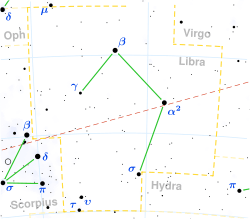Iota1 Librae
 Map of the constellation of Libra. | |
| Observation data Epoch J2000.0 Equinox J2000.0 (ICRS) | |
|---|---|
| Constellation | Libra |
| Right ascension | 15h 12m 13.29025s[1] |
| Declination | −19° 47′ 30.1592″[1] |
| Apparent magnitude (V) | +4.54[1] |
| Characteristics | |
| Evolutionary stage | Blue subgiant |
| Spectral type | B9IVpSi[1] |
| U−B color index | −0.38[1] |
| B−V color index | -0.08[1] |
| Variable type | Alpha2 Canum Venaticorum |
| Astrometry | |
| Radial velocity (Rv) | -11.6[1] km/s |
| Proper motion (μ) | RA: -35.40[1] mas/yr Dec.: -32.79[1] mas/yr |
| Parallax (π) | 8.59 ± 0.25[1] mas |
| Distance | 380 ± 10 ly (116 ± 3 pc) |
| Absolute magnitude (MV) | -0.79 |
| Other designations | |
Iota1 Librae (ι1 Lib) is a star in the constellation Libra. Its apparent magnitude is 4.54. It is located 379 light years from earth.[3]
Visibility
Due to its southern location, although the star can be seen from most regions of the earth, observers in the southern hemisphere are more advantaged. Near Antarctica, it appears circumpolar, while it always remains invisible only in the vicinity of the Arctic Circle. Its magnitude of 4.5 means that naked-eye visibility is dependent on a sky sufficiently free from the effects of light pollution.
The best time for observation in the evening sky falls in the months between May and September; from both hemispheres of the period of visibility remains approximately the same, thanks to the position of the star not far from the celestial equator.
Physical
Iota1 Librae is a variable star of the Alpha2 Canum Venaticorum type. Its magnitude varies from 4.53 to 4.56, while its spectrum shows variability and enhanced abundance of Silicon.[4] Iota1 Librae is also a multiple star; two stars are very close together (0.2 arcsec away), respectively of magnitude 5.1 and 5.5 and are named Iota Librae Aa and Ab.[5][6]
A third component is located 57 arcsec distant; it is a star of the tenth magnitude, Iota1 Librae B.[3] The third component is also a double star, of equal magnitudes, 1.9 arcseconds apart.[7]
Due to its position on the ecliptic, it is sometimes obscured by the Moon or planets. The last lunar occultation took place April 4, 2012.[8]
References
- 1 2 3 4 5 6 7 8 9 10 11 SIMBAD, Iota Librae (accessed 23 December 2014)
- ↑ Vizier
- 1 2 Extended Hipparcos Compilation (XHIP) (+ Anderson, 2012)
- ↑ General Catalogue of Variable Stars (Samus + 2007-2012)
- ↑ The Washington Visual Double Star Catalog (Mason + 2001-2012).
- ↑ Alcyone
- ↑ Burnam's Celestial Handbook, pp. 1107-1108.
- ↑ "Moon occults ι Librae (2012-04-09 02:03 CEST)". Turin Astronomical Observatory. Retrieved March 23, 2012.